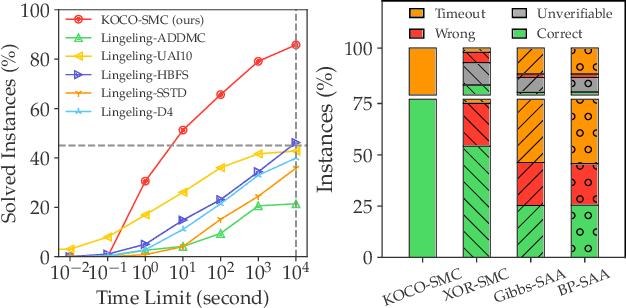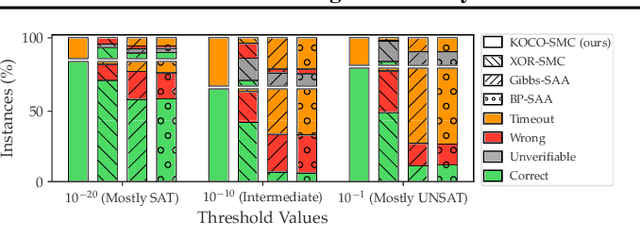Yexiang Xue
CALM: Contextual Analog Logic with Multimodality
Jun 17, 2025Abstract:In this work, we introduce Contextual Analog Logic with Multimodality (CALM). CALM unites symbolic reasoning with neural generation, enabling systems to make context-sensitive decisions grounded in real-world multi-modal data. Background: Classic bivalent logic systems cannot capture the nuance of human decision-making. They also require human grounding in multi-modal environments, which can be ad-hoc, rigid, and brittle. Neural networks are good at extracting rich contextual information from multi-modal data, but lack interpretable structures for reasoning. Objectives: CALM aims to bridge the gap between logic and neural perception, creating an analog logic that can reason over multi-modal inputs. Without this integration, AI systems remain either brittle or unstructured, unable to generalize robustly to real-world tasks. In CALM, symbolic predicates evaluate to analog truth values computed by neural networks and constrained search. Methods: CALM represents each predicate using a domain tree, which iteratively refines its analog truth value when the contextual groundings of its entities are determined. The iterative refinement is predicted by neural networks capable of capturing multi-modal information and is filtered through a symbolic reasoning module to ensure constraint satisfaction. Results: In fill-in-the-blank object placement tasks, CALM achieved 92.2% accuracy, outperforming classical logic (86.3%) and LLM (59.4%) baselines. It also demonstrated spatial heatmap generation aligned with logical constraints and delicate human preferences, as shown by a human study. Conclusions: CALM demonstrates the potential to reason with logic structure while aligning with preferences in multi-modal environments. It lays the foundation for next-gen AI systems that require the precision and interpretation of logic and the multimodal information processing of neural networks.
An Exact Solver for Satisfiability Modulo Counting with Probabilistic Circuits
Mar 02, 2025



Abstract:Satisfiability Modulo Counting (SMC) is a recently proposed general language to reason about problems integrating statistical and symbolic artificial intelligence. An SMC formula is an extended SAT formula in which the truth values of a few Boolean variables are determined by probabilistic inference. Existing approximate solvers optimize surrogate objectives, which lack formal guarantees. Current exact solvers directly integrate SAT solvers and probabilistic inference solvers resulting in slow performance because of many back-and-forth invocations of both solvers. We propose KOCO-SMC, an integrated exact SMC solver that efficiently tracks lower and upper bounds in the probabilistic inference process. It enhances computational efficiency by enabling early estimation of probabilistic inference using only partial variable assignments, whereas existing methods require full variable assignments. In the experiment, we compare KOCO-SMC with currently available approximate and exact SMC solvers on large-scale datasets and real-world applications. Our approach delivers high-quality solutions with high efficiency.
Active Symbolic Discovery of Ordinary Differential Equations via Phase Portrait Sketching
Sep 02, 2024Abstract:Discovering Ordinary Differential Equations (ODEs) from trajectory data is a crucial task in AI-driven scientific discovery. Recent methods for symbolic discovery of ODEs primarily rely on fixed training datasets collected a-priori, often leading to suboptimal performance, as observed in our experiments in Figure 1. Inspired by active learning, we explore methods for querying informative trajectory data to evaluate predicted ODEs, where data are obtained by the specified initial conditions of the trajectory. Chaos theory indicates that small changes in the initial conditions of a dynamical system can result in vastly different trajectories, necessitating the maintenance of a large set of initial conditions of the trajectory. To address this challenge, we introduce Active Symbolic Discovery of Ordinary Differential Equations via Phase Portrait Sketching (APPS). Instead of directly selecting individual initial conditions, APPS first identifies an informative region and samples a batch of initial conditions within that region. Compared to traditional active learning methods, APPS eliminates the need for maintaining a large amount of data. Extensive experiments demonstrate that APPS consistently discovers more accurate ODE expressions than baseline methods using passively collected datasets.
A Tighter Convergence Proof of Reverse Experience Replay
Aug 30, 2024Abstract:In reinforcement learning, Reverse Experience Replay (RER) is a recently proposed algorithm that attains better sample complexity than the classic experience replay method. RER requires the learning algorithm to update the parameters through consecutive state-action-reward tuples in reverse order. However, the most recent theoretical analysis only holds for a minimal learning rate and short consecutive steps, which converge slower than those large learning rate algorithms without RER. In view of this theoretical and empirical gap, we provide a tighter analysis that mitigates the limitation on the learning rate and the length of consecutive steps. Furthermore, we show theoretically that RER converges with a larger learning rate and a longer sequence.
Vertical Symbolic Regression via Deep Policy Gradient
Feb 01, 2024Abstract:Vertical Symbolic Regression (VSR) recently has been proposed to expedite the discovery of symbolic equations with many independent variables from experimental data. VSR reduces the search spaces following the vertical discovery path by building from reduced-form equations involving a subset of independent variables to full-fledged ones. Proved successful by many symbolic regressors, deep neural networks are expected to further scale up VSR. Nevertheless, directly combining VSR with deep neural networks will result in difficulty in passing gradients and other engineering issues. We propose Vertical Symbolic Regression using Deep Policy Gradient (VSR-DPG) and demonstrate that VSR-DPG can recover ground-truth equations involving multiple input variables, significantly beyond both deep reinforcement learning-based approaches and previous VSR variants. Our VSR-DPG models symbolic regression as a sequential decision-making process, in which equations are built from repeated applications of grammar rules. The integrated deep model is trained to maximize a policy gradient objective. Experimental results demonstrate that our VSR-DPG significantly outperforms popular baselines in identifying both algebraic equations and ordinary differential equations on a series of benchmarks.
Vertical Symbolic Regression
Dec 19, 2023Abstract:Automating scientific discovery has been a grand goal of Artificial Intelligence (AI) and will bring tremendous societal impact. Learning symbolic expressions from experimental data is a vital step in AI-driven scientific discovery. Despite exciting progress, most endeavors have focused on the horizontal discovery paths, i.e., they directly search for the best expression in the full hypothesis space involving all the independent variables. Horizontal paths are challenging due to the exponentially large hypothesis space involving all the independent variables. We propose Vertical Symbolic Regression (VSR) to expedite symbolic regression. The VSR starts by fitting simple expressions involving a few independent variables under controlled experiments where the remaining variables are held constant. It then extends the expressions learned in previous rounds by adding new independent variables and using new control variable experiments allowing these variables to vary. The first few steps in vertical discovery are significantly cheaper than the horizontal path, as their search is in reduced hypothesis spaces involving a small set of variables. As a consequence, vertical discovery has the potential to supercharge state-of-the-art symbolic regression approaches in handling complex equations with many contributing factors. Theoretically, we show that the search space of VSR can be exponentially smaller than that of horizontal approaches when learning a class of expressions. Experimentally, VSR outperforms several baselines in learning symbolic expressions involving many independent variables.
Hypothesis Network Planned Exploration for Rapid Meta-Reinforcement Learning Adaptation
Nov 07, 2023Abstract:Meta Reinforcement Learning (Meta RL) trains agents that adapt to fast-changing environments and tasks. Current strategies often lose adaption efficiency due to the passive nature of model exploration, causing delayed understanding of new transition dynamics. This results in particularly fast-evolving tasks being impossible to solve. We propose a novel approach, Hypothesis Network Planned Exploration (HyPE), that integrates an active and planned exploration process via the hypothesis network to optimize adaptation speed. HyPE uses a generative hypothesis network to form potential models of state transition dynamics, then eliminates incorrect models through strategically devised experiments. Evaluated on a symbolic version of the Alchemy game, HyPE outpaces baseline methods in adaptation speed and model accuracy, validating its potential in enhancing reinforcement learning adaptation in rapidly evolving settings.
Integrating Symbolic Reasoning into Neural Generative Models for Design Generation
Oct 13, 2023Abstract:Design generation requires tight integration of neural and symbolic reasoning, as good design must meet explicit user needs and honor implicit rules for aesthetics, utility, and convenience. Current automated design tools driven by neural networks produce appealing designs, but cannot satisfy user specifications and utility requirements. Symbolic reasoning tools, such as constraint programming, cannot perceive low-level visual information in images or capture subtle aspects such as aesthetics. We introduce the Spatial Reasoning Integrated Generator (SPRING) for design generation. SPRING embeds a neural and symbolic integrated spatial reasoning module inside the deep generative network. The spatial reasoning module decides the locations of objects to be generated in the form of bounding boxes, which are predicted by a recurrent neural network and filtered by symbolic constraint satisfaction. Embedding symbolic reasoning into neural generation guarantees that the output of SPRING satisfies user requirements. Furthermore, SPRING offers interpretability, allowing users to visualize and diagnose the generation process through the bounding boxes. SPRING is also adept at managing novel user specifications not encountered during its training, thanks to its proficiency in zero-shot constraint transfer. Quantitative evaluations and a human study reveal that SPRING outperforms baseline generative models, excelling in delivering high design quality and better meeting user specifications.
Solving Satisfiability Modulo Counting for Symbolic and Statistical AI Integration With Provable Guarantees
Sep 16, 2023Abstract:Satisfiability Modulo Counting (SMC) encompasses problems that require both symbolic decision-making and statistical reasoning. Its general formulation captures many real-world problems at the intersection of symbolic and statistical Artificial Intelligence. SMC searches for policy interventions to control probabilistic outcomes. Solving SMC is challenging because of its highly intractable nature($\text{NP}^{\text{PP}}$-complete), incorporating statistical inference and symbolic reasoning. Previous research on SMC solving lacks provable guarantees and/or suffers from sub-optimal empirical performance, especially when combinatorial constraints are present. We propose XOR-SMC, a polynomial algorithm with access to NP-oracles, to solve highly intractable SMC problems with constant approximation guarantees. XOR-SMC transforms the highly intractable SMC into satisfiability problems, by replacing the model counting in SMC with SAT formulae subject to randomized XOR constraints. Experiments on solving important SMC problems in AI for social good demonstrate that XOR-SMC finds solutions close to the true optimum, outperforming several baselines which struggle to find good approximations for the intractable model counting in SMC.
Racing Control Variable Genetic Programming for Symbolic Regression
Sep 13, 2023Abstract:Symbolic regression, as one of the most crucial tasks in AI for science, discovers governing equations from experimental data. Popular approaches based on genetic programming, Monte Carlo tree search, or deep reinforcement learning learn symbolic regression from a fixed dataset. They require massive datasets and long training time especially when learning complex equations involving many variables. Recently, Control Variable Genetic Programming (CVGP) has been introduced which accelerates the regression process by discovering equations from designed control variable experiments. However, the set of experiments is fixed a-priori in CVGP and we observe that sub-optimal selection of experiment schedules delay the discovery process significantly. To overcome this limitation, we propose Racing Control Variable Genetic Programming (Racing-CVGP), which carries out multiple experiment schedules simultaneously. A selection scheme similar to that used in selecting good symbolic equations in the genetic programming process is implemented to ensure that promising experiment schedules eventually win over the average ones. The unfavorable schedules are terminated early to save time for the promising ones. We evaluate Racing-CVGP on several synthetic and real-world datasets corresponding to true physics laws. We demonstrate that Racing-CVGP outperforms CVGP and a series of symbolic regressors which discover equations from fixed datasets.
 Add to Chrome
Add to Chrome Add to Firefox
Add to Firefox Add to Edge
Add to Edge